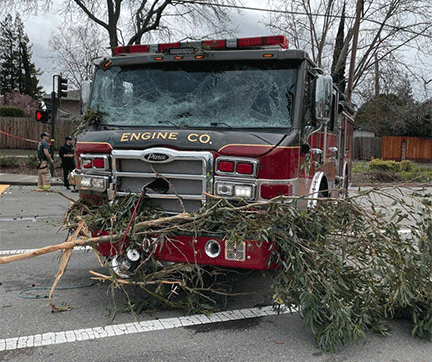Today in Walnut Creek, a Contra Costa County Fire Protection District fire engine was damaged during a wind storm.
According to the District, Engine 7 was struck and damaged by a fallen tree around 12:00 pm. All three firefighters were sent for medical evaluation. No other information was released.
As of 2:00 pm, more than 88,000 PG&E customers were without power and Contra Costa County Fire has been inundated by wires down calls, fallen trees and other damages from the wind.
Here are the number of customers impacted by storm-related outages in each Bay Area region (East Bay includes Contra Costa County and Alameda County):
| March 14 – 2 PM | Affected Customers |
| San Francisco | 1,839 |
| Peninsula | 61,967 |
| North Bay | 7,439 |
| East Bay | 88,621 |
| South Bay | 114,763 |
| Total | 274,629 |

PG&E Mobilizing for Powerful Winter Storm
PG&E has been preparing for this storm. PG&E has a plan, and we will execute that plan. This includes the use of storm outage prediction models that help us determine the potential timing, location and number of power outages.
In advance of the latest storm, PG&E vegetation management crews were out working to keep trees away from powerlines during the forecasted wet and windy weather to reduce the risk of outages caused by downed trees and other vegetation. The adverse weather can result in trees, limbs and other debris falling into powerlines, damaging equipment, and interrupting electric service.
Ahead of storms, PG&E stages power poles, powerlines, transformers and other electric equipment at yards throughout our service territory in preparation to restore power to affected areas safely and as quickly as possible. In addition, local PG&E operations emergency centers will activate in impacted regions to more efficiently allocate crews, materials and other resources to restoration efforts.
Customer Storm Preparedness and Safety Tips
-
- PG&E encourages customers to have a plan, prepare for power outages and above all else, stay safe. Visit www.pge.com/stormsafety for preparedness tips.
- Customers can get updates on outages in their neighborhood through a variety of channels.
-
- Access our Electric Outage Map online at pge.com/outages
- Contact our outage information line at 1-800-743-5002
- Customers can also log-in to their account through pge.com and sign up to receive proactive outage alerts through email, text or phone.
-
- Never touch downed wires: If you see a downed power line, assume it is energized and extremely dangerous. Do not touch or try to move it—and keep children and animals away. Report downed power lines immediately by calling 911 and by calling PG&E at 1-800-743-5002.
- Floods and landslides can cause severe damage to the gas system. PG&E will be monitoring the storm event, and if required, would be isolating the gas system from a safe distance from the flood water:
- In the most saturated areas, PG&E will have workers ready to reinforce gas infrastructure and make repairs.
- PG&E gas service representatives will also venture into flooded neighborhoods to shut off gas meters in order to prevent water intrusion into the gas system.
- Once the floodwaters recede, PG&E will restore gas and electric service to the community.
- When returning to their homes, customers should not attempt to turn on their gas or electricity. They should contact PG&E at 1-800-743-5000 to request that their services be restored.
- Some city and/or county officials may require that premises be inspected before re- establishing gas and electric service. In such cases, PG&E cannot restore service until an inspection has been completed.
- Use flashlights, not candles: During a power outage, use battery-operated flashlights, and not candles, due to the risk of fire. If you must use candles, please keep them away from drapes, lampshades, animals and small children. Do not leave candles unattended.
- Have a backup phone: If you have a telephone system that requires electricity to work, such as a cordless phone or answering machine, plan to have a standard telephone or cellular phone ready as a backup.
- Have fresh drinking water, ice: Freeze plastic containers filled with water to make blocks of ice that can be placed in your refrigerator/freezer during an outage to prevent foods from spoiling. Blue Ice from your picnic cooler also works well in the freezer.
- Secure outdoor furniture: Deck furniture, lightweight yard structures and decorative lawn items should be secured as they can be blown by high winds and damage overhead power lines and property.
- Use generators safely: Customers with standby electric generators should make sure they are properly installed by a licensed electrician in a well-ventilated area. Improperly installed generators pose a significant danger to customers, as well as crews working on power lines. If using portable generators, be sure they are in a well-ventilated area.
- Turn off appliances: If you experience an outage, unplug or turn off all electrical appliances to avoid overloading circuits and to prevent fire hazards when power is restored. Simply leave a single lamp on to alert you when power returns. Turn your appliances back on one at a time when conditions return to normal.
- Safely clean up: After the storm has passed, be sure to safely clean up. Never touch downed wires and always call 8-1-1 or visit 811express.com at least two full business days before digging to have all underground utilities safely marked.

